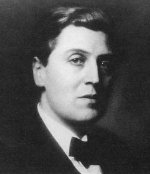

He wrote songs as a youth but had no serious musical education before his lessons with Schönberg, which began in 1904. Webern was a pupil at the same time, a crucial period in Schönberg's creative life, when he was moving rapidly towards and into atonality. Berg's Piano Sonata op.1 (1908) is still tonal, but the Four Songs op.2 (1910) move away from key and the op.3 String Quartet (1910) is wholly atonal; it is also remarkable in sustaining, through motivic development, a larger span when the instrumental works of Schönberg and Webern were comparatively momentary. Berg dedicated it to his wife Helene, whom he married in 1911.
Then came the Five Songs for soprano op.4 (1912), miniatures setting poetic instants by Peter Altenberg. This was Berg's first orchestral score, and though it shows an awareness of Schönberg, Mahler and Debussy, it is brilliantly conceived and points towards Wozzeck - and towards 12-note serialism, notably in its final passacaglia. More immediately Berg produced another set of compact statements, the Four Pieces for clarinet and piano op.5 (1913), then returned to large form with the Three Orchestral Pieces op.6 (1915), a thematically linked sequence of prelude, dance movement and funeral march. The prelude begins and ends in the quiet noise of percussion; the other two movements show Berg's discovery of how traditional forms and stylistic elements (including tonal harmony) might support big structures.
 In
May 1914 Berg saw the Vienna premiere of Büchner's Woyzeck
and formed the plan of setting it. He started the opera in 1917, while
he was in the Austrian army (1915-18), and finished it in 1922. He made
his own selection from the play's fragmentary scenes to furnish a three-act
libretto for formal musical setting: the first act is a suite of five character
pieces (five scenes showing the simple soldier Wozzeck in different relationships),
the second a five-movement symphony (for the disintegration of his liaison
with Marie), the third a set of five inventions on different ostinato ideas
(for the tragedy's brutally nihilist climax). The close musical structuring,
extending to small details of timing, may be seen as an analogue for the
mechanical alienness of the universe around Büchner's central characters,
though Berg's music crosses all boundaries, from atonal to tonal (there
is a Mahlerian interlude in d Minor), from speech to song, from café
music to sophisticated textures of dissonant counterpoint. Wozzeck
had its premiere in Berlin in 1925 and thereafter was widely produced,
bringing Berg financial security.
In
May 1914 Berg saw the Vienna premiere of Büchner's Woyzeck
and formed the plan of setting it. He started the opera in 1917, while
he was in the Austrian army (1915-18), and finished it in 1922. He made
his own selection from the play's fragmentary scenes to furnish a three-act
libretto for formal musical setting: the first act is a suite of five character
pieces (five scenes showing the simple soldier Wozzeck in different relationships),
the second a five-movement symphony (for the disintegration of his liaison
with Marie), the third a set of five inventions on different ostinato ideas
(for the tragedy's brutally nihilist climax). The close musical structuring,
extending to small details of timing, may be seen as an analogue for the
mechanical alienness of the universe around Büchner's central characters,
though Berg's music crosses all boundaries, from atonal to tonal (there
is a Mahlerian interlude in d Minor), from speech to song, from café
music to sophisticated textures of dissonant counterpoint. Wozzeck
had its premiere in Berlin in 1925 and thereafter was widely produced,
bringing Berg financial security.
His next work, the Chamber Concerto for violin, piano and 13 wind (1925), moves decisively towards a more classical style: its three formally complex movements are still more clearly shaped than those of the op.6 set and the scoring suggests a response to Stravinskian objectivity. The work is also threaded through with ciphers and numerical conceits, making it a celebration of the triune partnership of Schönberg, Berg and Webern. Then came the Lyric Suite for string quartet (1926), whose long-secret programme connects it with Berg's intimate feelings for Hanna Fuchs-Robettin - feelings also important to him in the composition of his second opera, Lulu (1929-35). The suite, in six movements of increasingly extreme tempo, uses 12-note serial along with other material in projecting a quasi-operatic development towards catastrophe and annulment. The development of Lulu was twice interrupted by commissioned works, the concert aria Der Wein on poems by Baudelaire (1929) and the Violin Concerto (1935), and it remained unfinished at Berg's death: his widow placed an embargo on the incomplete third act which could not be published or performed until 1979. As with Wozzeck, he made his own libretto out of stage material, this time choosing two plays by Wedekind, whom he had long admired for his treatment of sexuality. Dramatically and musically the opera is a huge palindrome, showing Lulu's rise through society in her successive relationships and then her descent into prostitution and eventual death at the hands of Jack the Ripper. Again the score is filled with elaborate formal schemes, around a lyricism unloosed by Berg's individual understanding of 12-note serialism. Something of its threnodic sensuality is continued in the Violin Concerto, designed as a memorial to the teenage daughter of Mahler's widow.
(see also article: The Second Viennese School)